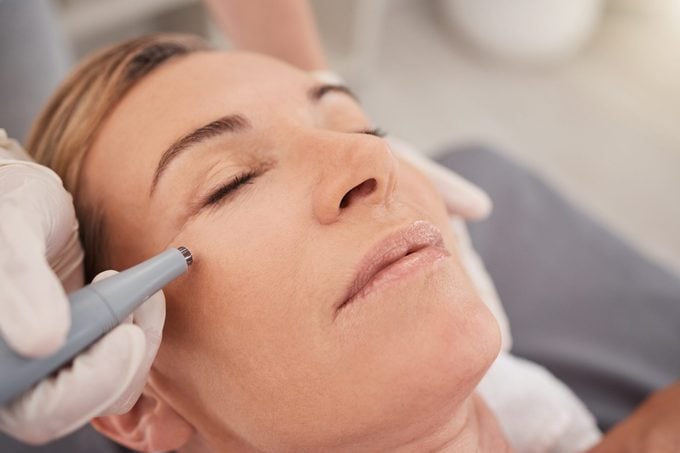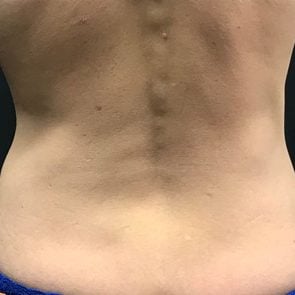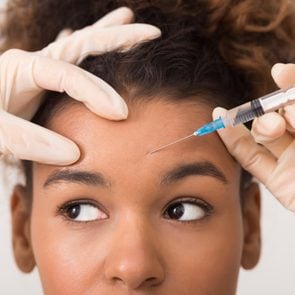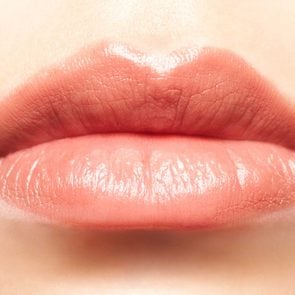Skin-Tightening Treatments in 2023 That Can Take Years Off Your Face
Updated: Jan. 25, 2023
Meet the technological advances that have made face lifts nearly obsolete.
There’s a growing cultural attitude about aging that’s less demanding than it’s been in decades past about the obligation to look “young” at any age. Instead, this fresher awareness recognizes what’s most important in middle-age is that your body and mind are healthy and in balance.
It’s a welcomed shift—and in a beautiful way, it doesn’t throw the classic notion of “beauty” entirely to the wayside. In fact, from nutrition to sound sleep, exercise, and spirituality, this modern sense of wellness is intricately linked with a conscious investment in taking superb care of yourself.
In particular, your face, is well, in your face these days. That’s thanks to the rise of Zoom meetings, video chats with loved ones during lockdown, and social media … trends that have us examining our appearances in inquisitive new ways. “We’re looking at our faces all day, and we’re also seeing them from different angles that we never saw before,” says Lenox Hill Hospital clinical attending cosmetic dermatologic surgeon Howard Sobel, MD. “All of a sudden, the camera is tilted to the side, and ‘yikes, I didn’t know I had that jowl or neckband or that one brow was higher than the other,’” he says.
Just as communications technology has leaped forward, so has skin technology, producing many tools that tighten and sculpt your face without the risks, costs, and recovery of the traditional face or eye lift. “The technology has advanced so much over the last decade,” says board-certified dermatologist Bruce Katz, MD, Director of Juva Skin and Laser Center in Manhattan and Clinical Professor of Dermatology at the Icahn School of Medicine at Mt. Sinai. “We have these new non-invasive treatments that are safe, effective, easy to do, and there’s no downtime.”
Why we seek skin tightening
By our mid-20s, production of collagen, the protein that makes skin firm and smooth, begins to decrease by about one percent every year, according to Dendy E. Engelman, M.D., FACMS, FASDS, FAAD, Director of Dermatology, Mohs Surgery and Laser Medicine at the Shafer Clinic Fifth Avenue. “Gradually, our skin becomes less firm and elastic as proteins break down and moisture retention declines, leading to volume loss and skin loosening, commonly in the cheeks and around the eyes,” she says. You might also see sagging in the jawline, jowls, and neck as well as fine lines around “dynamic” (more expressive) parts of the face, such as the forehead, eyes, and mouth, Dr. Engelman adds. UV damage and inflammation can further decrease collagen.
How skin care products can help with skin tightening
“Topical products work modestly at best,” Dr. Katz says. He points to a short list of active ingredients—retinoic acid, retinol, and prescription Retin A—that help slow the aging process. Skin also gets a little boost, he adds, from glycolic acid, which increases cell turnover, and antioxidants such as vitamin C and green tea, which help reduce free radical damage.
Dr. Sobel, on the other hand, is a little more optimistic about the anti-aging power of topicals. He just received a patent for a high-concentration retinol product that speeds cell turnover to resurface skin and lock in hydration without irritation. “It helps keep water in the skin,” he says. “And a lot of looking younger is just hydration.”
If you’re looking for more powerful anti-aging effects, consider the newest non-invasive skin-tightening treatments on the market—including ultrasound skin tightening, radio frequency skin tightening, and laser skin tightening. Dr. Sobel says for patients ranging from their late twenties into their sixties, and beyond, it’s possible that “these procedures will really work.”
Tools for non-invasive skin-tightening

Ultrasound skin-tightening
Ultherapy
Ultrasound, such as Ultherapy, is an FDA-approved skin-tightening technology that delivers micro-focused ultrasound energy deep into the lower layers of the skin to trigger active collagen production. It’s often used to tighten the neck, jowls, chest, and brow areas, where the skin is a little thinner. “It’s great for patients who want impressive results but can afford to wait a couple of months and possibly attend multiple sessions if needed,” Dr. Engelman says.
- Pros: Proven to smooth wrinkles and tighten skin; no downtime; no scarring.
- Cons: Some patients find it painful; requires multiple sessions and two to three months to see full results; some 20 to 30 percent of people don’t respond to it, according to Dr. Katz.
Sofwave
An alternative to Ultherapy is Sofwave, which uses Synchronous Ultrasound Parallel Beam technology—a type of ultrasound that passes through the surface of the skin, heating the mid-dermal tissue to rejuvenate collagen fibers and tighten skin. It’s FDA-cleared to lift the eyebrow, neck, and submental tissue (between the chin and neck), and to reduce the appearance of fine lines and wrinkles.
- Pros: Sofwave is non-invasive with zero downtime and minimal discomfort, according to board-certified New York City dermatologist Amy B. Lewis, MD. “The cooling mechanism, coupled with the ultrasound technology, allows the heat energy to bypass the outer layer of the skin and instead focus directly on the dermal layer, targeting and remodeling the collagen and elastin, where it’s most abundant.” The treatment is also safe for all skin types and tones.
- Cons: Effects aren’t immediate, according to Dr. Lewis. “Collagen and elastin remodeling begin six weeks post-procedure,” which means you could be waiting three to six months to see changes. And for optimal results, you may need up to three treatments.
Radio frequency skin-tightening
Radio frequency skin-tightening has been used since 2001, but newer innovations have made it state of the art. There are some 12 or 13 different RF devices on the market, including Vivace, Evoke, Evolve, Thermage, Thermi, Thermalift, Exilis, Profound RF, NuEra Tight, Morpheus, Sublime, and Emsculpt NEO, all of which use controlled radio waves to heat the dermis and sub-dermal layers of the skin, promoting production of new collagen and elastin and encouraging cell turnover, according to the American Board of Cosmetic Surgery, to help firm and thicken skin without the risk of discoloration, so it’s safe for all skin tones.
Let’s take a closer look at three popular radio frequency (RF) treatments:
Thermage
Introduced in 2002, Thermage is a monopolar radio frequency treatment for the face and body. According to Dr. Engelman, it works by sending radio frequency energy into deeper levels of the skin to contract the collagen there and create micro-injuries that stimulate the body to produce more collagen as they heal over time, reducing loose, crepey skin. A cooling tip helps reduce discomfort. Dr. Engelman uses Thermage to smooth and firm skin around the eyes, on the cheeks, and the jawline, and on the stomach and legs. She says she performs three to five Thermage treatments a day.
- Pros: No downtime; any minor pain, redness, or swelling should go away within 24 hours; there are some immediate firming effects; results may last one to two years.
- Cons: It can take up to six months to see the full results; monopolar radio frequency penetrates deeper and may be more painful than the bipolar radio frequency of newer devices.
Vivace
With Vivace, one of the newer RF devices, bipolar radio frequency energy is combined with microneedling, which uses tiny gold-tipped needles to create microinjuries in the skin and to deliver skin-boosting ingredients such as peptides in addition to radio frequency energy. “Radio frequency really works nicely—but when you combine it with microneedling, you get a synergistic effect,” Dr. Sobel says. “The skin gets back to acting younger, making more collagen, with cell turnover once every 28 days instead of once every 35 to 40 days.” Vivace also uses red light therapy to decrease inflammation and blue light therapy to decrease sebum and the bacteria that cause acne.
- Pros: Almost no downtime—any redness or needle marks go away within six to 24 hours; uses bipolar radio frequency, thought to be more tolerable than mono radio frequency; results last two to three years.
- Cons: It can take four weeks to see results; typically requires three to four treatments, six weeks apart.
Evoke
Using an applicator that straps onto the cheeks or chin, Evoke delivers consistent bipolar radio frequency energy deep into the skin’s subdermal layer to heat the Fibro Septal Network (FSN), the fibrous bands that give skin its structure. Evoke is FDA-cleared for skin tightening and fat reduction.
Evoke Face tightens and contours the cheeks; Evoke Neck lifts and tightens the jawline, jowls, and the under-chin area. Dr. Katz believes Evoke is one of the most effective skin-tightening technologies available today, and says his device is running all day long, administering 40-minute treatments that feel like “a warm massage.”
- Pros: Treatment is pain-free and hands-free; there’s no downtime.
- Cons: Requires three to four 45-minute treatments, one week apart.
Laser skin tightening
Laser treatments such as Clear + Brilliant, Fraxel Dual, and SkinTyte deliver high heat to the top layers of skin to stimulate the production of collagen and elastin, improving skin’s texture and tone, according to Dr. Engelman. “Laser light treatments work by targeting various pigments within the skin and superheating them to create a controlled micro-injury that stimulates the body’s natural healing processes,” she explains. Laser treatments may also minimize dark spots, fine lines, blemishes, pore size, and acne scars.
- Pros: Not painful; you may see immediate results that improve with subsequent sessions; any redness and swelling subsides within a few days.
- Cons: May require four to six treatments three to four weeks apart; more intense lasers (Fraxel, Picosure, and other Erbium, CO2, or fractionated lasers) can cause damage and hyperpigmentation on darker skin tones; all laser treatments may cause flare-ups of cold sores and eczema.
Whichever skin-tightening treatment you choose, Dr. Sobel suggests the results you get will depend on your genetics, your degree of sun damage, and your expectations.
But—as with any self-care practice—if it’s worth it to you, then it’s worth it.
Stay up on keeping your skin, and the rest of you, healthy as can be: subscribe to The Healthy newsletter, and follow us on Facebook and Instagram.
And, for more …



















